torque PORSCHE 911 TURBO 2004 4.G Information Manual
[x] Cancel search | Manufacturer: PORSCHE, Model Year: 2004, Model line: 911 TURBO, Model: PORSCHE 911 TURBO 2004 4.GPages: 61, PDF Size: 2.14 MB
Page 6 of 61
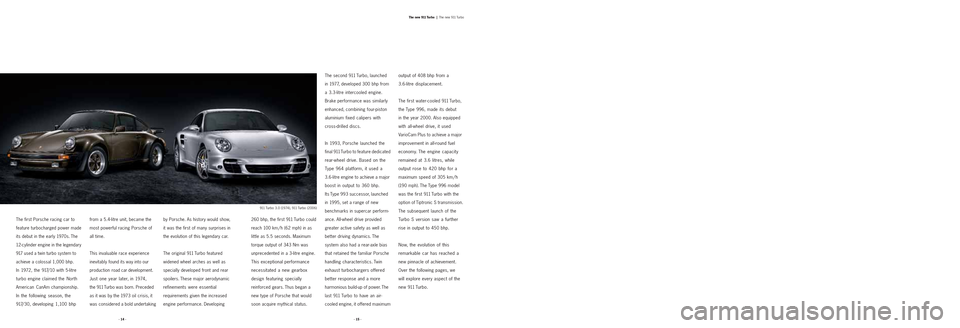
· 14 ·· 15 ·The new 911 Turbo |
The new 911 Turbo
The second 911 Turbo, launched
in 1977, developed 300 bhp from
a 3.3-litre intercooled engine.
Brake performance was similarly
enhanced, combining four-piston
aluminium fixed calipers with
cross-drilled discs.
In 1993, Porsche launched the
final 911Turbo to feature dedicated
rear-wheel drive. Based on the
Type 964 platform, it used a
3.6-litre engine to achieve a major
boost in output to 360 bhp.
Its Type 993 successor, launched
in 1995, set a range of new
benchmarks in supercar perform-
ance. All-wheel drive provided
greater active safety as well as
better driving dynamics. The
system also had a rear-axle bias
that retained the familiar Porsche
handling characteristics. Twin
exhaust turbochargers offered
better response and a more
harmonious build-up of power. The
last 911 Turbo to have an air-
cooled engine, it offered maximum
output of 408 bhp from a
3.6-litre displacement.
The first water-cooled 911 Turbo,
the Type 996, made its debut
in the year 2000. Also equipped
with all-wheel drive, it used
VarioCam Plus to achieve a major
improvement in all-round fuel
economy. The engine capacity
remained at 3.6 litres, while
output rose to 420 bhp fo r a
maximum speed of 305 km / h
(190 mph). The Type 996 model
was the first 911 Turbo with the
option of Tiptronic S transmission.
The subsequent launch of the
Turbo S version saw a further
rise in output to 450 bhp.
Now, the evolution of this
remarkable car has reached a
new pinnacle of achievement.
Over the following pages, we
will explore every aspect of the
new 911 Turbo.The first Porsche racing car to
feature turbocharged power made
its debut in the early 1970s. The
12-cylinder engine in the legendary
917 used a twin turbo system to
achieve a colossal 1,000 bhp
.
In 1972, the 917/10 with 5-litre
turbo engine claimed the North
American CanAm
championship.
In the following season, the
917/30, developing 1,100 bhp
from a 5.4-litre unit, became the
most powerful racing Porsche of
all time.
This invaluable race experience
inevitably found its way into our
production
road car development.
Just one year later, in 1974,
the 911 Turbo was born. Preceded
as it was by the 1973 oil crisis, it
was considered a
bold undertakingby Porsche. As history would show,
it was the first of many surprises in
the evolution of this legendary car.
The original 911 Turbo featured
widened wheel arches as well as
specially developed front and rear
spoilers. These major aerodynamic
refinements were essential
requirements given the increased
engine performance. Developing260 bhp, the first 911 Turbo could
reach 100 km / h (62 mph) in as
little as 5.5 seconds. Maximum
torque output of 343 Nm was
unprecedented in a 3-litre engine.
This exceptional performance
necessitated a new gearbox
design featuring specially
reinforced gears. Thus began a
new type of Porsche that would
soon acquire mythical status.
911 Turbo 3.0 (1974), 911 Turbo (2006)
Page 7 of 61
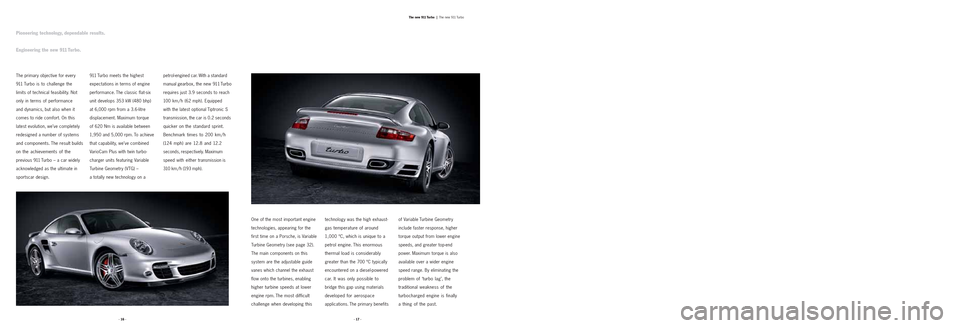
The primary objective for every
911 Turbo is to challenge the
limits of technical feasibility. Not
only in terms of performance
and dynamics, but also when it
comes to ride comfort. On this
latest evolution, we’ve completely
redesigned a number of systems
and components. The result builds
on the achievements of the
previous 911 Turbo – a car widely
acknowledged as the ultimate in
sportscar design.
As you would expect, the new 911 Turbo meets the highest
expectations in terms of engine
performance. The classic flat-six
unit develops 353 kW (480 bhp)
at 6,000 rpm from a 3.6-litre
displacement. Maximum torque
of 620 Nm is available between
1,950 and 5,000 rpm. To achieve
that capability, we’ve combined
VarioCam Plus with twin turbo-
charger units featuring Variable
Turbine Geometry (VTG) –
a totally new technology on apetrol-
engined car. With a standard
manual
gearbox, the new 911 Turbo
requires just 3.9 seconds to reach
100 km / h (62 mph). Equipped
with the latest optional Tiptronic S
transmission, the car is 0.2 seconds
quicker on the standard sprint.
Benchmark times to 200 km / h
(124 mph) are 12.8 and
12 . 2
seconds, respectively. Maximum
speed with either transmission is
310 km / h (193 mph).
One of the most important engine
technologies, appearing for the
first time on a Porsche, is Variable
Turbine Geometry (see page 32).
The main components on this
system are the adjustable guide
vanes which channel the exhaust
flow onto the turbines, enabling
higher turbine speeds at lower
engine rpm. The most difficult
challenge when developing this
technology was the high exhaust-
gas temperature of around
1,000 ºC, which is unique to a
petrol engine. This enormous
thermal load is considerably
greater than the 700 ºC typically
encountered on a diesel-powered
car. It was only possible to
bridge this gap using materials
developed for aerospace
applications. The primary benefitsof Variable Turbine Geometry
include faster response, higher
torque output from lower engine
speeds, and greater top-end
power. Maximum torque is also
available over a wider engine
speed range. By eliminating the
problem of ‘turbo lag’, the
traditional weakness of the
turbocharged engine is finally
a thing of the past.
· 16 ·· 17 ·The new 911 Turbo |
The new 911 Turbo
Pioneering technology, dependable results.
Engineering the new 911 Turbo.
Page 8 of 61
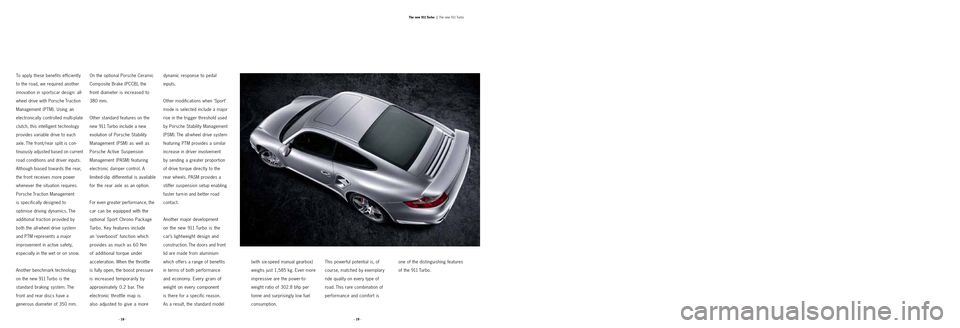
To apply these benefits efficiently
to the road, we required another
innovation in sportscar design: all-
wheel drive with Porsche Traction
Management (PTM). Using an
electronically controlled multi-plate
clutch, this intelligent technology
provides variable drive to each
axle. The front/rear split is con-
tin
uously adjusted based on current
road conditions and driver inputs.
Although biased towards the rear,
the front receives more power
whenever the situation requires.
Porsche Traction Management
is specifically designed to
optimise driving dynamics. The
additional traction provided by
both the all-wheel drive system
and PTM represents a major
improvement in active safety,
especially in the wet or on snow.
Another benchmark technology
on the new 911 Turbo is the
standard braking system. The
front and rear discs have a
generous diameter of 350 mm.On the optional Porsche Ceramic
Composite Brake (PCCB), the
front diameter is increased to
380 mm.
Other standard features on the
new 911 Turbo include a new
evolution of Porsche Stability
Management (PSM) as well as
Porsche Active Suspension
Management (PASM) featuring
electronic damper control.
A
limited-slip differential is available
for the rear axle as an option.
For even greater performance, the
car can be equipped with the
optional Sport Chrono Package
Turbo. Key features include
an ‘overboost’ function which
provides as much as 60 Nm
of additional torque under
acceleration. When the throttle
is fully open, the boost pressure
is increased temporarily by
approximately 0.2 bar. The
electronic throttle map is
also adjusted to give a more
dynamic response to pedal
inputs.
Other modifications when ‘Sport’
mode is selected include a major
rise in the trigger threshold used
by Porsche Stability Management
(PSM). The all-wheel drive system
featuring PTM provides a similar
increase in driver involvement
by sending a greater proportion
of drive torque directly to the
rear wheels. PASM provides a
stiffer suspension setup enabling
faster turn-in and better road
contact.
Another major development
on the new 911 Turbo is the
car’s lightweight design and
construction. The doors and front
lid are made from aluminium
which offers a range of benefits
in terms of both performance
and economy. Every gram of
weight on every component
is there for a specific reason.
As a result, the standard model (with six-speed manual gearbox)
weighs just 1,585 kg. Even more
impressive are the power-to-
weight ratio of 302.8 bhp per
tonne and surprisingly low fuel
consumption.This powerful potential is, of
course, matched by exemplary
ride quality on every type of
road. This rare combination of
performance and comfort is one of the distinguishing features
of the 911 Turbo.
· 18 ·· 19 ·The new 911 Turbo |
The new 911 Turbo
Page 11 of 61
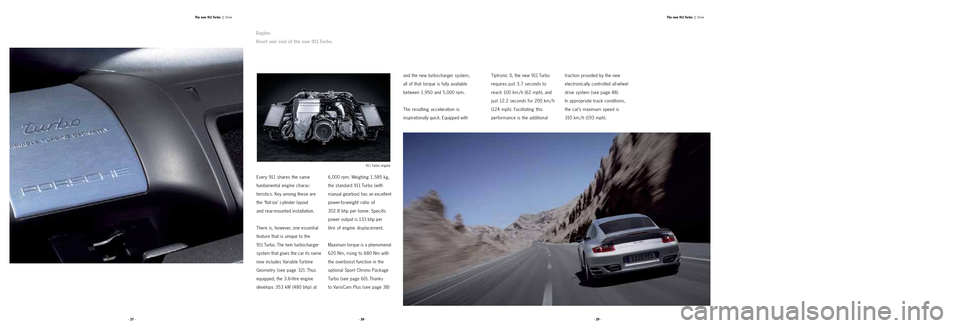
Tiptronic S, the new 911 Turbo
requires just 3.7 seconds to
reach 100 km / h (62 mph), and
just 12.2 seconds for 200 km / h
(124 mph). Facilitating this
performance is the additionaltraction provided by the new
electronically controlled all-wheel
drive system (see page 48).
In appropriate track conditions,
the car’s maximum speed is
310 km / h (193 mph).
· 29 ·The new 911 Turbo |
Drive
Every 911 shares the same
fundamental engine charac-
teristics. Key among these are
the ‘flat-six’ cylinder layout
and rear-mounted installation.
There is, however, one essential
feature that is unique to the
911 Turbo. The twin turbocharger
system that gives the car its name
now includes Variable Turbine
Geometry (see page 32). Thus
equipped, the 3.6-litre engine
develops 353 kW (480 bhp) at6,000 rpm. Weighing 1,585 kg,
the standard 911 Turbo (with
manual gearbox) has an excellent
power-to-weight ratio of
302.8 bhp per tonne. Specific
power output is 133 bhp per
litre of engine displacement.
Maximum torque is a phenomenal
620 Nm, rising to 680 Nm with
the overboost function in the
optional Sport Chrono Package
Turbo (see page 60). Thanks
to VarioCam Plus (see page 38)and the new turbocharger system,
all of that torque is fully available
between 1,950 and 5,000 rpm.
The resulting acceleration is
inspirationally quick. Equipped with
· 28 · · 27 ·The new 911 Turbo |
Drive
Engine.
Heart and soul of the new 911 Turbo.
911 Turbo engine
Page 12 of 61

Lightweight design.
The six-cylinder boxer engine is
a highly compact unit offering
excellent cylinder charging and
torque characteristics as well
as optimum balance and minimal
vibration. With the cylinders
arranged horizontally on either
side of the crankshaft, the
layout is key to the car’s low
centre of gravity.
The alloy crankcase consists
of two main sections, each
containing one bank of cylinders.
The crankshaft runs in eight main
bearings and is driven by forged
connecting rods. For optimum
durability, we’ve used forged
aluminium pistons running in
Nikasil-coated aluminium liners
and featuring individual oil-spray
cooling. Key benefits include lower
frictional resistance and longer
service life.
The cylinder heads are made
from a lightweight alloy which
is extremely resistant to high
temperature. Each bank of
cylinders has two overhead
camshafts driving a set of four
valves – two inlet and two exhaust
– on each individual cylinder.
The valves are arranged in a ‘V’
configuration and feature a highly
efficient dual-spring design.
Engine performance is further
enhanced with the aid of bothVariable Turbine Geometry (VTG –
see page 32) and VarioCam Plus
(variable valve timing and lift
on inlet side – see page 38). The
benefits are not only greater
power and torque, but also better
fuel economy and lower emissions.
Dry-sump lubrication.
This classic dry-sump system
with separate oil reservoir
ensures consistent oil pressures
throughout the engine. In doing
so, it compensates for even the
most extreme and prolonged
gravitational loads.
After passing through the engine,
every drop of oil is returned
directly to the external reservoir.
The flow is driven by two pairs of
scavenge pumps in the cylinder
heads and a further two pumps in
the crankcase. Gas is removed
from the returning oil by means of
a defoaming device in the
reservoir. As a result, the oil
level in the reservoir remains
virtually constant at all times.
The oil is returned to the
lubrication points in the engine
by means of a dedicated
oil-feed pump. With a further
scavenge pump in each of the
twin turbocharger units, the
new 911 Turbo has a total of nineseparate pumps to drive the
lubrication system.
The oil level can be checked from
inside the car via the standard
on-board computer. This solution
is not only cleaner and more
convenient than a conventional
dipstick, it is also significantly
more accurate.
· 30 ·· 31 ·The new 911 Turbo |
Drive
Main rotating assembly and valve gear
Page 13 of 61
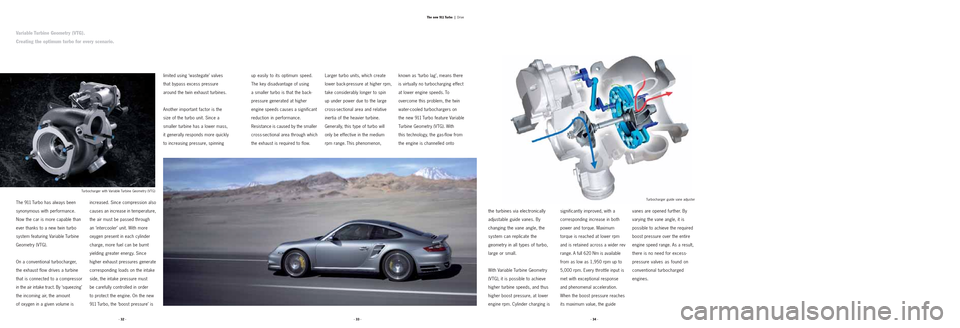
vanes are opened further. By
varying the vane angle, it is
possible to achieve the required
boost pressure over the entire
engine speed range. As a result,
there is no need for excess-
pressure valves as found on
conventional turbocharged
engines.
· 34 · · 32 ·· 33 ·The new 911 Turbo |
Drive
Variable Turbine Geometry (VTG).
Creating the optimum turbo for every scenario.
known as ‘turbo lag’, means there
is virtually no turbocharging effect
at lower engine speeds. To
overcome this problem, the twin
water-cooled turbochargers on
the new 911 Turbo feature Variable
Turbine Geometry (VTG). With
this technology, the gas-flow from
the engine is channelled onto Larger turbo units, which create
lower back-pressure at higher rpm,
take considerably longer to spin
up under power due to the large
cross-sectional area and relative
inertia of the heavier turbine.
Generally, this type of turbo will
only be effective in the medium
rpm range. This phenomenon,
Turbocharger guide vane adjuster Turbocharger with Variable Turbine Geometry (VTG)
up easily to its optimum speed.
The key disadvantage of using
a smaller turbo is that the back-
pressure generated at higher
engine speeds causes a significant
reduction in performance.
Resistance is caused by the smaller
cross-sectional area through which
the exhaust is required to flow.
The 911 Turbo has always been
synonymous with performance.
Now the car is more capable than
ever thanks to a new twin turbo
system featuring Variable Turbine
Geometry (VTG).
On a conventional turbocharger,
the exhaust flow drives a turbine
that is connected to a compressor
in the air intake tract. By ‘squeezing’
the incoming air, the amount
of oxygen in a given volume isincreased. Since compression also
causes an increase in temperature,
the air must be passed through
an ‘intercooler’ unit. With more
oxygen present in each cylinder
charge, more fuel can be burnt
yielding greater energy. Since
higher exhaust pressures generate
corresponding loads on the intake
side, the intake pressure must
be carefully controlled in order
to protect the engine. On the new
911 Turbo, the ‘boost pressure’ islimited using ‘wastegate’ valves
that bypass excess pressure
around the twin exhaust turbines.
Another important factor is the
size of the turbo unit. Since a
smaller turbine has a lower mass,
it generally responds more quickly
to increasing pressure, spinning
the turbines via electronically
adjustable guide vanes. By
changing the vane angle, the
system can replicate the
geometry in all types of turbo,
large or small.
With Variable Turbine Geometry
(VTG), it is possible to achieve
higher turbine speeds, and thus
higher boost pressure, at lower
engine rpm. Cylinder charging issignificantly improved, with a
corresponding increase in both
power and torque. Maximum
torque is reached at lower rpm
and is retained across a wider rev
range. A full 620 Nm is available
from as low as 1,950 rpm up to
5,000 rpm. Every throttle input is
met with exceptional response
and phenomenal acceleration.
When the boost pressure reaches
its maximum value, the guide
Page 14 of 61
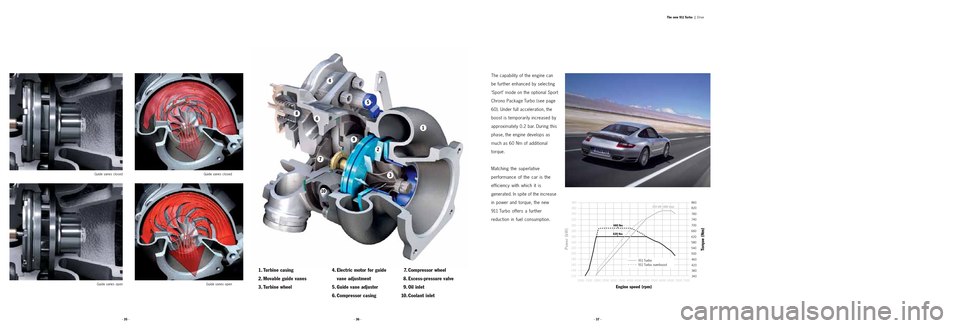
· 36 · · 35 ·· 37 ·The new 911 Turbo |
Drive
Guide vanes open Guide vanes closedGuide vanes open Guide vanes closed
The capability of the engine can
be further enhanced by selecting
‘Sport’ mode on the optional Sport
Chrono Package Turbo (see page
60). Under full acceleration, the
boost is temporarily increased by
approximately 0.2 bar. During this
phase, the engine develops as
much as 60 Nm of additional
torque.
Matching the superlative
performance of the car is the
efficiency with which it is
generated. In spite of the increase
in power and torque, the new
911 Turbo offers a further
reduction in fuel consumption.
1
2
3
4
5
6
7
8
9
10
1. Turbine casing
2. Movable guide vanes
3. Turbine wheel4. Electric motor for guide
vane adjustment
5. Guide vane adjuster
6. Compressor casing7. Compressor wheel
8. Excess-pressure valve
9. Oil inlet
10. Coolant inlet340 500 540
580
620 660 700
220 240
260
280
300
1500
7500 2000 2500 3000 3500 4000 4500 5000 5500 6000 6500 7000
380 420
460
1000
Power (kW)
Engine speed (rpm)
620 Nm
120 140
160
180
200
Torque (Nm)
680 Nm
740 320
340 360380780 820860
353 kW (480 bhp)
911 Turbo
911 Turbo overboost
Page 15 of 61
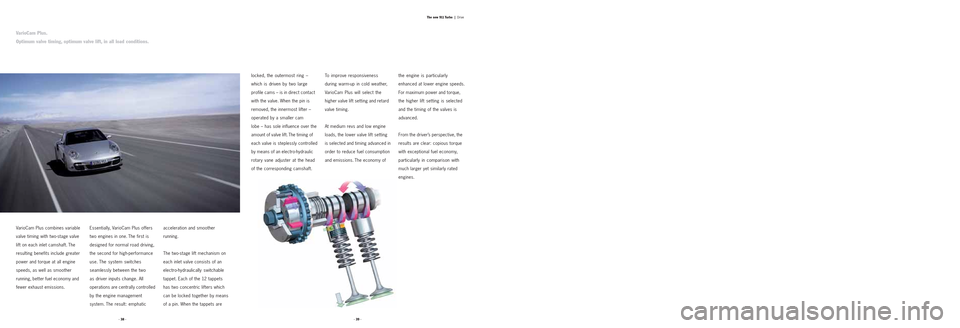
locked, the outermost ring –
which is driven by two large
profile cams – is in direct contact
with the valve. When the pin is
removed, the innermost lifter –
operated by a smaller cam
lobe – has sole influence over the
amount of valve lift. The timing of
each valve is steplessly controlled
by means of an electro-hydraulic
rotary vane adjuster at the head
of the corresponding camshaft.To improve responsiveness
during warm-up in cold weather,
VarioCam Plus will select the
higher valve lift setting and retard
valve timing.
At medium revs and low engine
loads, the lower valve lift setting
is selected and timing advanced in
order to reduce fuel consumption
and emissions. The economy of
the engine is particularly
enhanced at lower engine speeds.
For maximum power and torque,
the higher lift setting is selected
and the timing of the valves is
advanced.
From the driver’s perspective, the
results are clear: copious torque
with exceptional fuel economy,
particularly in comparison with
much larger yet similarly rated
engines.
· 39 ·The new 911 Turbo |
Drive
VarioCam Plus combines variable
valve timing with two-stage valve
lift on each inlet camshaft. The
resulting benefits include greater
power and torque at all engine
speeds, as well as smoother
running, better fuel economy and
fewer exhaust emissions.Essentially, VarioCam Plus offers
two engines in one. The first is
designed for normal road driving,
the second for high-performance
use. The system switches
seamlessly between the two
as driver inputs change. All
operations are centrally controlled
by the engine management
system. The result: emphaticacceleration and smoother
running.
The two-stage lift mechanism on
each inlet valve consists of an
electro-hydraulically switchable
tappet. Each of the 12 tappets
has two concentric lifters which
can be locked together by means
of a pin. When the tappets are
· 38 ·
VarioCam Plus.
Optimum valve timing, optimum valve lift, in all load conditions.
Page 18 of 61

are reduced thanks to lengthy
replacement intervals for both
the engine oil (18,000 miles) and
air filter unit (36,000 miles). The
spark plugs require changing after
36,000 miles or a maximum of
every four years. The generator,
power-steering pump and air-
conditioning compressor are all
driven by a single self-adjusting
belt with a service life of 54,000
miles. The hydraulic tappets
provide automatic adjustment of
all valve clearances, while the
drive chains on the camshafts
and auxiliary shafts will also last
the life of the car.
Basic servicing is required after
18,000 miles or a maximum of
two years on the road. The first
major service is due at 36,000
miles or every four years at the
latest. The results: lower running
costs and virtually uninterrupted
enjoyment from your Porsche.
Exhaust system.
The exhaust system on the
911 Turbo is made from highly
durable stainless steel. The
system consists of two separate
tracts, one for each bank of
cylinders. The catalytic converters
are extremely heat-resistant,
yet quick to reach temperature
(and thus optimum performance)
when the engine is started
from cold.Twin lambda sensors in each of
the exhausts enable continuous
monitoring of the combustion
process. An additional pair of
sensors* is used to measure
the efficiency of the catalytic
converters.
Servicing.
Another pleasant surprise on the
new 911 Turbo is the standard
service schedule. Running costs
The new six-speed manual
gearbox in the 911 Turbo is
specifically adapted to the car’s
high levels of engine torque.
Designed primarily for sports
driving, one immediate
characteristic is the perfectly
judged spread betweensuccessive ratios as you upshift
through the gears. The gearshift
throw is short and precise,
with only minimal force required.
Thanks to a dual-mass flywheel,
this uncompromising setup means
there’s never any compromise
in comfort. The linkage provides
a direct connection with the
gearbox while insulating
the lever from engine vibration.
One final detail – the new gear
lever design – is exclusive to
the 911 Turbo.
· 44 ·· 45 ·The new 911 Turbo |
Drive
Six-speed manual gearbox.
Superlative power requires equal precision.
Gear lever exclusive to 911 Turbo* Not in markets with leaded fuel.
Page 20 of 61
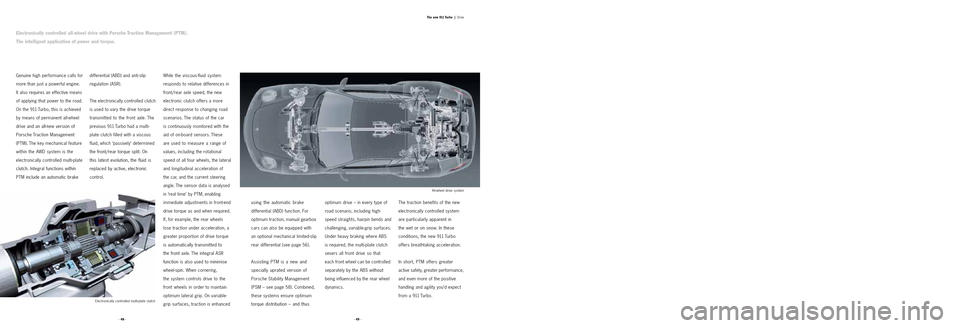
using the automatic brake
differential (ABD) function. For
optimum traction, manual gearbox
cars can also be equipped with
an optional mechanical limited-slip
rear differential (see page 56).
Assisting PTM is a new and
specially uprated version of
Porsche Stability Management
(PSM – see page 58). Combined,
these systems ensure optimum
torque distribution – and thus
optimum drive – in every type of
road scenario, including high-
speed straights, hairpin bends and
challenging, variable-grip surfaces.
Under heavy braking where ABS
is required, the multi-plate clutch
severs all front drive so that
each front wheel can be controlled
separately
by the ABS without
being influenced by the rear wheel
dynamics.
The traction benefits of the new
electronically controlled system
are particularly apparent in
the wet or on snow. In these
conditions, the new 911 Turbo
offers breathtaking acceleration.
In short, PTM offers greater
active safety, greater performance,
and even more of the positive
handling and agility you’d expect
from a 911 Turbo.
· 49 ·The new 911 Turbo |
Drive
differential (ABD) and anti-slip
regulation (ASR).
The electronically controlled clutch
is used to vary the drive torque
transmitted to the front axle. The
previous 911 Turbo had a multi-
plate clutch filled with a viscous
fluid, which ‘passively’ determined
the front/rear torque split. On
this latest evolution, the fluid is
replaced by active, electronic
control.While the viscous-fluid system
responds to relative differences in
front/rear axle speed, the new
electronic clutch offers a more
direct response to changing road
scenarios. The status of the car
is continuously monitored with the
aid of on-board sensors. These
are used to measure a range of
values, including the rotational
speed of all four wheels, the lateral
and longitudinal acceleration of
the car, and the current steering
angle. The sensor data is analysed
in ‘real time’ by PTM, enabling
immediate adjustments in front-end
drive torque as and when required.
If, for example, the rear wheels
lose traction under acceleration, a
greater proportion of drive torque
is automatically transmitted to
the front axle. The integral ASR
function is also used to minimise
wheel-spin. When
cornering,
the system controls drive to the
front wheels in order to maintain
optimum lateral grip. On variable-
grip surfaces, traction is enhanced
· 48 · Electronically controlled multi-plate clutchAll-wheel drive system
Genuine high performance calls for
more than just a powerful engine.
It also requires an effective means
of applying that power to the road.
On the 911 Turbo, this is achieved
by means of permanent all-wheel
drive and an all-new version of
Porsche Traction Management
(PTM). The key mechanical feature
within the AWD system is the
electronically controlled multi-plate
clutch. Integral functions within
PTM include an automatic brake
Electronically controlled all-wheel drive with Porsche Traction Management (PTM).
The intelligent application of power and torque.